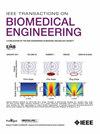Video-PSG: An Intelligent Contactless Monitoring System for Sleep Staging
IF 4.4
2区 医学
Q2 ENGINEERING, BIOMEDICAL
引用次数: 0
Abstract
Polysomnography (PSG) is the gold standard for sleep staging in clinics, but its skin-contact nature makes it uncomfortable and inconvenient to use for long-term sleep monitoring. As a complementary part of PSG, the video cameras are not utilized to their full potential, only for manual check of simple sleep events, thereby ignoring the potential for physiological and semantic measurement. This leads to a pivotal research question: Can camera be used for sleep staging, and to what extent? We developed a camera-based contactless sleep staging system in the Institute of Respiratory Diseases and created a clinical video dataset of 20 adults. The camera-based feature set, derived from both physiological signals (pulse and breath) and motions all measured from a video, was evaluated for 4-class sleep staging (Wake-REM-Light-Deep). Three optimization strategies were proposed to enhance the sleep staging accuracy: using motion metrics to prune measurement outliers, creating a more personalized model based on the baseline calibration of waking-stage physiological signals, and deriving a specialized feature for REM detection. It achieved the best accuracy of 73.1% (kappa = 0.62, F1-score = 0.74) in the benchmark of five sleep-staging classifiers. Notably, the system exhibited high accuracy in predicting the overall sleep structure and subtle changes between different sleep stages. The study demonstrates that camera-based contactless sleep staging is a new value stream for sleep medicine, which also provides clinical and technical insights for future optimization and implementation.视频-PSG:用于睡眠分期的非接触式智能监测系统。
多导睡眠图(PSG)是诊所进行睡眠分期的黄金标准,但其皮肤接触的特性使其在用于长期睡眠监测时既不舒适又不方便。作为 PSG 的补充部分,摄像机并没有充分发挥其潜力,只是用于手动检查简单的睡眠事件,从而忽视了生理和语义测量的潜力。这就引出了一个关键的研究问题:摄像头是否可用于睡眠分期,以及在多大程度上可用于睡眠分期?我们在呼吸疾病研究所开发了基于摄像头的非接触式睡眠分期系统,并创建了一个包含 20 名成人的临床视频数据集。基于摄像头的特征集来源于生理信号(脉搏和呼吸)和从视频中测量到的运动,该特征集针对 4 级睡眠分期(清醒-快速眼动-浅睡眠-深睡眠)进行了评估。为提高睡眠分期的准确性,提出了三种优化策略:使用运动指标清除测量异常值;基于清醒阶段生理信号的基线校准创建更个性化的模型;以及为快速眼动检测提供专门的特征。在五个睡眠分期分类器的基准测试中,该系统达到了 73.1% 的最佳准确率(kappa = 0.62,F1-score = 0.75)。值得注意的是,该系统在预测整体睡眠结构和不同睡眠阶段之间的细微变化方面表现出很高的准确性。这项研究表明,基于摄像头的非接触式睡眠分期是睡眠医学的新价值流,也为未来的优化和实施提供了临床和技术见解。
本文章由计算机程序翻译,如有差异,请以英文原文为准。
求助全文
约1分钟内获得全文
求助全文
来源期刊

IEEE Transactions on Biomedical Engineering
工程技术-工程:生物医学
CiteScore
9.40
自引率
4.30%
发文量
880
审稿时长
2.5 months
期刊介绍:
IEEE Transactions on Biomedical Engineering contains basic and applied papers dealing with biomedical engineering. Papers range from engineering development in methods and techniques with biomedical applications to experimental and clinical investigations with engineering contributions.
 求助内容:
求助内容: 应助结果提醒方式:
应助结果提醒方式:


